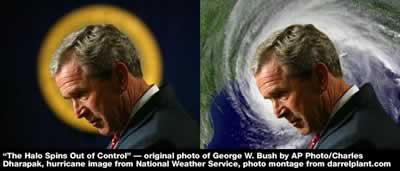Three days before Hurricane Katrina devastated much of the Gulf Coast and swamped New Orleans, almost every “news” discussion show on cable was talking about the Natalee Holloway missing persons case, just as they’d done for most of the previous three months.
Hannity, van Sustern, Grace, King, Abrams, Cosby, Scarborough. Much of their summer had been spent talking about Aruba. If people in New Orleans had been watching them for “information” they’d have been screwed.
And, once the disaster struck — just as after the terrorist attacks of 9/11 — people wondered if it meant that a new dedication to real issues was going to take hold. Skeptics like myself were doubtful, but I hoped that given the scale of the disaster that it might deserve at least an equal amount of time as the Holloway case has. We have been proven, regretfully, wrong.
Of the seven shows we picked who aired substantial reports on Holloway the Friday before the hurricane hit Alabama, Mississippi, and Louisiana, four of them have already gone back to the story, adding in yet another MWF (missing white female) in most cases. And they all did it last week, only a couple of weeks after Katrina struck.
FOX’s Greta van Sustern had Beth Holloway Twitty (Natalee’s mother) on as a guest Friday, 16 September, after congratulating herself for not having any shows on the subject since the storm (although she said “we monitor it daily”). Twitty, according to van Sustern, “understood this.” But c’mon now, get over it, N’awlins!
CNN’s Nancy Grace beat everyone to the punch on 13 September — two weeks and a day after Katrina — devoting the last quarter of her show to an interview with Twitty, after spending the rest of the program on the real — but somehow predictable for Grace — issue of sex offenders spread out over the country as evacuees. Twitty makes the charge that the news focus on Katrina gave cover to the Aruban government to let the suspects in her daughter’s disappearance go. Neat tie-in.
On MSNBC, Rita Cosby took up the gauntlet the next day (14 September) while bodies were still floating in the canals of Bayou St. John. In a short segment, she talked to both Twitty and Antonio Carlo, the attorney for Joran van der Sloot, the primary suspect in Holloway’s disappearance. Again, the idea that the press focus on Katrina took the heat off the Aruban authorities was brought forth, this time by Cosby.
That same night, Dan Abrams of MSNBC interviewed Twitty. At the end of the interview he remarked:
I can just tell you that even in the aftermath of the hurricane we were still getting a lot of e-mails from people saying please have Beth back on. Please update us on the story. Let us know whats going on.
The next night, he took some flak for the piece (emphasis added:
Last night I spoke to Beth Holloway Twitty, the mother of missing Alabama student Natalee Holloway, missing from Aruba since May 30.
Jeanmarie Miller from Flint, Michigan, “Natalees mother made a comment that the Aruban government was trying to hide behind Katrina in making some of the recent rulings in the cases against Joran van der Sloot and the Kalpoe brothers. Was she suggesting that the Aruban justice system should have been put on hold until her daughters story was once again front page news?”
Howard Aronoff, “I object to you continuing to allow Natalees mother, Beth, to make totally unsubstantiated claims that Joran van der Sloot and the two Kalpoe brothers raped and killed Natalee. She continues to refer to a myriad of statements made by the three, which support the claim. I cant recall a single time that these so-called statements were acknowledged by Aruban officials. At best they are the result of leaks from unauthorized people and might even be invented out of thin air.”
Howard, youre right that theyre unsubstantiated and I made that point, but regardless, dont expect the Aruban authorities to acknowledge it the same way American authorities wouldnt either. I also dont care if they were leaked by unauthorized individuals. I only care if it is true. And youre right. We do not know if it is true. And thats why we had on his lawyer tonight.
From Beckley, West Virginia, Frances Thompson. “I know the Katrina coverage and Supreme Court coverage is more important right now, but I appreciate the time you gave to let us know how things are going in the Natalee Holloway case.”
But J. Doyle from San Francisco, “Taking time away from the tragedy of likely thousands of mainly poor African Americans to again present the Aruban story suggests the disappearance of one rich white girl is somehow on par. It is not.”
Well considering it is the first time we did a segment on it after weeks of 24-hour Katrina coverage, it is hard to argue that were suggesting it is on par and I think actually I made the point in response to someone who wrote in that many of my viewers probably disagree that were not doing enough Natalee Holloway coverage.
A number of you writing saying you want more, more, more. Ive got to tell you, I dont think the majority of you want that, but I know, I know. People are going to write in and say yes you do.
That would be two weeks of coverage of Hurricane Katrina versus three months of Natalee Holloway coverage.
 Via
Via 
